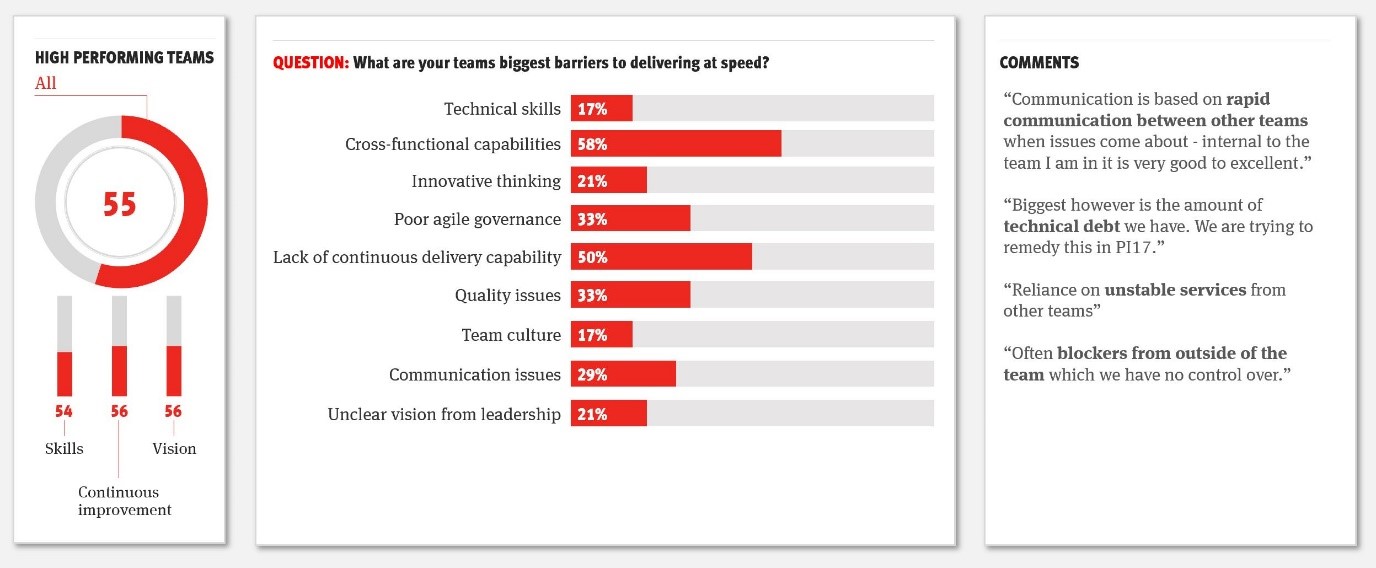Earlier this month we launched our new Agile Maturity Index (AMI), a unique framework and measurement tool that helps organisations assess the maturity of their agile transformation and drive improvements through data driven insights.
Running on Workbench, the organisational insights platform developed by Temporall, the AMI is based on decades of practical experience developing our own frameworks, research of multiple external frameworks and collaboration with behavioural scientists. The index is built around five foundational pillars of an agile organisation:

Each pillar (or macro attribute) has three micro attributes within it. Using real data from an anonymised implementation of the AMI to drive insights from a large-scale engineering team, this five-part blog series will step through the initial outputs from each pillar in turn.

As you can’t scale something unless it’s working perfectly at a smaller scale, we will begin by looking at the High Performing Teams macro attribute.
From the initial survey data, the platform will quickly highlight areas that require focus as well as areas of strength to be leveraged. Although less important than the trend analysis that will build over time for both quantitative and qualitative data, it is important to analyse the distribution of these high-level scores at all levels to understand whether there is disagreement across the teams.
Through the High Performing Teams micro attributes we are able to analyse whether the teams have the skills and tools they need to deliver value relatively independently, whether they feel able to drive up their output through continuous improvement cycles and how connected they feel with the overall objectives and vision of the business to ensure the efficacy of that output.
In the example below, we have teams that have high levels of trust but are flagging that the business tends to just tell them what features to build and doesn’t clearly define the outcomes that the organisation is looking for as well as they could.

As well as the quantitative data from the questions, qualitative data comes from sentiment analysis on the comments that team members can add to questions which are then analysed by Workbench’s AI engine. In the case of the High Performing Teams macro attribute in this example, the sentiment is relatively low compared to the quantitative score. This isn’t unusual since team members will tend to write more negative comments than positive ones. What will be important is looking at ways to improve in these areas and to then demonstrate that sentiment from the teams around a macro or micro attribute is improving over time.
Finally, we can drill down into specific questions within High Performing Teams to view anonymised comments and to draw deeper insights from the spread of answers to specific questions. Here we can see the teams are flagging an issue in their lack of cross-functional capabilities but highlighting a positive team culture.
 In a full analysis of the AMI data we would go on to focus more specifically on quantitative and sentiment analysis within each of the three micro attributes in order to produce recommendations for focus areas across the next few weeks and months. In later posts we’ll look at how we support teams with the right levels of governance, technologies and backing from the wider organisation. We will also explore how we use the platform to report and benchmark with a focus on improving innovation, speed to market and efficacy of output to unlock opportunities and drive commercial success.
In a full analysis of the AMI data we would go on to focus more specifically on quantitative and sentiment analysis within each of the three micro attributes in order to produce recommendations for focus areas across the next few weeks and months. In later posts we’ll look at how we support teams with the right levels of governance, technologies and backing from the wider organisation. We will also explore how we use the platform to report and benchmark with a focus on improving innovation, speed to market and efficacy of output to unlock opportunities and drive commercial success.
The second blog in the five-part series will focus on the Process & Governance macro attribute. In the meantime, if you’d like a demo or more information on how you can use the Agile Maturity Index to measurably improve your agile transformation, please drop me an email at james.c@mmtdigital.co.uk